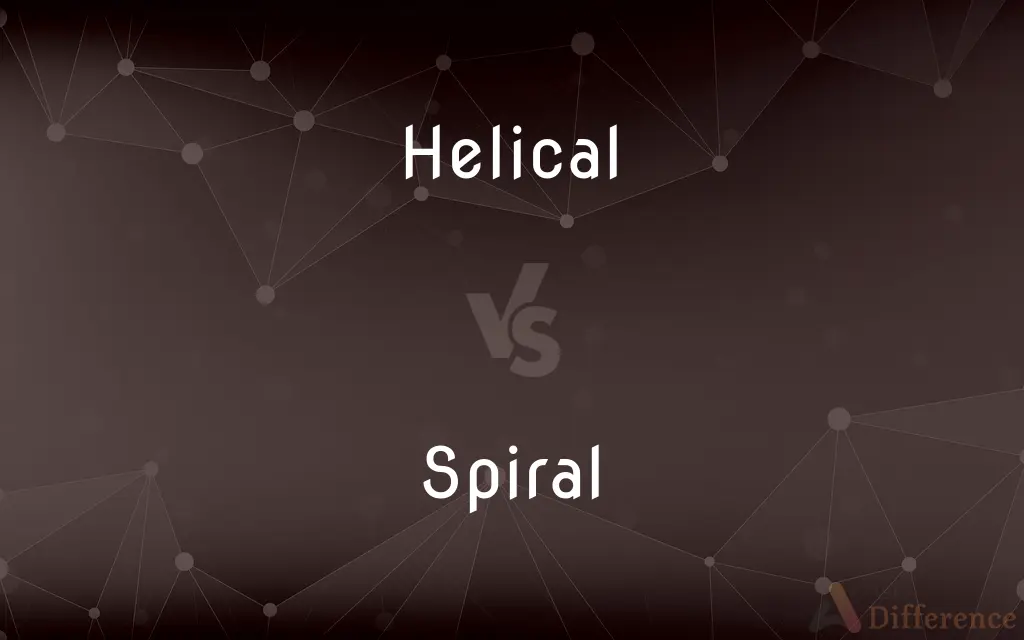Helical vs. Spiral — What's the Difference?
Edited by Tayyaba Rehman — By Maham Liaqat — Updated on April 2, 2024
Helical structures twist in a 3D form like a spring, while spirals are 2D or 3D but expand from the center.

Difference Between Helical and Spiral
Table of Contents
ADVERTISEMENT
Key Differences
Helical structures are characterized by their three-dimensional shape, where the curve runs around an axis in a constant direction, like the threads on a bolt. On the other hand, spiral structures can be two-dimensional, like the pattern on a snail's shell, or three-dimensional, like a spiral staircase, always moving outward from the center.
While helical forms maintain a consistent radius from their axis as they wind, creating a uniform structure, spirals often vary in their distance from the center, allowing for an increase or decrease in the space between each turn as they move outward or inward.
Helical designs are often found in nature in the form of DNA strands, showcasing their ability to compactly store information within a three-dimensional space. Spirals, however, are more visually represented in galaxies and weather patterns, emphasizing their expansive and dynamic nature.
In engineering and architecture, helical shapes are crucial for creating springs and screws, where the uniformity of the twist provides consistent force or securing capabilities. Spirals are utilized for their aesthetic appeal and functional design in staircases and ramps, offering a smooth transition between levels.
The mathematical study of helical shapes involves understanding the complexities of three-dimensional geometry, focusing on the fixed axis around which the shape twists. Spirals require a different mathematical approach, often involving polar coordinates to describe their curving path away from a central point.
ADVERTISEMENT
Comparison Chart
Dimensionality
3D
2D or 3D
Path
Constant direction around an axis
Expands or contracts from the center
Usage in Nature
DNA strands, tendrils
Galaxies, snail shells
Usage in Engineering
Springs, screws
Staircases, ramps
Mathematical Study
3D geometry, fixed axis
Polar coordinates, curving path
Compare with Definitions
Helical
A curve in three-dimensional space that winds around a cylinder or cone.
Helical gears in machinery allow for smooth power transmission.
Spiral
Relating to movement along a curved path around a central axis.
The water drained in a spiral motion.
Helical
Pertaining to or involving a spiral or twist.
The helical staircase in the old mansion added to its mysterious charm.
Spiral
A curve that winds around a fixed center point at a continuously increasing or decreasing distance.
The artist drew a spiral that started small and expanded outward.
Helical
A structure that twists around a central axis.
Helical antennas are used for satellite communication.
Spiral
A process of gradual but continuous change or development.
The discussion quickly went into a spiral of complexity.
Helical
Shaped like a helix; having a form that resembles a spring.
The helical structure of the DNA molecule is essential for its function.
Spiral
A shape or design that consists of a curve that circles around a central point.
The spiral galaxy could be clearly seen through the telescope.
Helical
Relating to a form that is uniform and spirals like a coil.
The helical spring compressed under the weight of the car.
Spiral
Pertaining to something that follows a circular and gradually expanding path.
The spiral staircase led to the top of the lighthouse.
Helical
Of or having the shape of a helix; spiral.
Spiral
In mathematics, a spiral is a curve which emanates from a point, moving farther away as it revolves around the point.
Helical
Having a shape approximating that of a helix.
Spiral
A curve on a plane that winds around a fixed center point at a continuously increasing or decreasing distance from the point.
Helical
In the shape of a helix.
Spiral
A three-dimensional curve that turns around an axis at a constant or continuously varying distance while moving parallel to the axis; a helix.
Helical
Of or pertaining to, or in the form of, a helix; spiral; as, a helical staircase; a helical spring.
Spiral
Something having the form of such a curve
A spiral of black smoke.
Helical
In the shape of a coil
Spiral
(Printing) A spiral binding.
Spiral
The course or flight path of an object rotating on its longitudinal axis.
Spiral
A continuously accelerating increase or decrease
The wage-price spiral.
Spiral
Of or resembling a spiral.
Spiral
Circling around a center at a continuously increasing or decreasing distance.
Spiral
Coiling around an axis in a constantly changing series of planes; helical.
Spiral
(Printing) Relating to or having a spiral binding
A spiral notebook.
Spiral
To take a spiral form or course.
Spiral
To rise or fall with steady acceleration.
Spiral
To cause to take a spiral form or course.
Spiral
(geometry) A curve that is the locus of a point that rotates about a fixed point while continuously increasing its distance from that point. Category:en:Curves
Spiral
(informal) A helix.
Spiral
A self-sustaining process with a lot of momentum involved, so it is difficult to accelerate or stop it at once.
Spiral
(rail) A section of track that forms a circle and crosses over itself, used for gaining height in mountainous territory.
Spiral
Helical, like a spiral.
Spiral
(intransitive) To move along the path of a spiral or helix.
Spiral
(transitive) To cause something to spiral.
Spiral
To increase continually.
Spiral
Winding or circling round a center or pole and gradually receding from it; as, the spiral curve of a watch spring.
Spiral
Winding round a cylinder or imaginary axis, and at the same time rising or advancing forward; winding like the thread of a screw; helical.
Spiral
Of or pertaining to a spiral; like a spiral.
Spiral
A plane curve, not reëntrant, described by a point, called the generatrix, moving along a straight line according to a mathematical law, while the line is revolving about a fixed point called the pole. Cf. Helix.
Spiral
Anything which has a spiral form, as a spiral shell.
Spiral
A plane curve traced by a point circling about the center but at ever-greater distances from it
Spiral
A curve that lies on the surface of a cylinder or cone and cuts the element at a constant angle
Spiral
Ornament consisting of a curve on a plane that winds around a center with an increasing distance from the center
Spiral
A structure consisting of something wound in a continuous series of loops;
A coil of rope
Spiral
Flying downward in a helical path with a large radius
Spiral
To wind or move in a spiral course;
The muscles and nerves of his fine drawn body were coiling for action
Black smoke coiling up into the sky
The young people gyrated on the dance floor
Spiral
Form a spiral;
The path spirals up the mountain
Spiral
Move in a spiral or zigzag course
Spiral
In the shape of a coil
Common Curiosities
How do helical and spiral shapes differ in their usage in engineering?
Helical shapes are used for functional components like springs and screws due to their consistent force, whereas spirals are often used for design and functionality in staircases and ramps.
Can spirals be three-dimensional?
Yes, spirals can be both two-dimensional and three-dimensional, like a spiral staircase.
What is the main difference between helical and spiral shapes?
Helical shapes twist in three dimensions around a central axis, while spiral shapes expand or contract from a center point in either two or three dimensions.
Is the distance from the center constant in helical shapes?
Yes, in helical shapes, the distance from the center or axis remains constant as the shape winds around it.
What are some applications of spiral designs in architecture?
Spiral staircases and ramps are prime examples of spiral designs in architecture.
How do spirals vary in their structure compared to helicals?
Spirals vary by increasing or decreasing their distance from the center, unlike the consistent radius of helical structures.
How do spirals appear in weather patterns?
Spirals can be seen in the formation of galaxies, cyclones, and hurricanes, showcasing their dynamic nature.
Can both helical and spiral shapes be found in nature?
Yes, both shapes are common in nature, with helical shapes like DNA strands and spiral shapes like galaxies and snail shells.
Can the concept of a helix apply to movements or only to static shapes?
The concept of a helix can apply to movements as well, such as in the path of certain particles or in the motion of some types of machinery.
What is a key mathematical difference between studying helical and spiral shapes?
Helical shapes involve studying three-dimensional geometry and a fixed axis, while spiral shapes are often studied using polar coordinates to describe their expansion from a center.
What are some common examples of helical structures in everyday life?
Common examples include springs in pens, screws, and the DNA molecule.
How does the mathematical study of spirals differ from that of helical shapes?
The study of spirals often involves polar coordinates to account for the curve's expansion from a point, contrasting with the fixed axis study of helical shapes.
Why are helical gears preferred in some machinery?
Helical gears are preferred for their ability to operate more smoothly and quietly than straight-cut gears due to the angled teeth engaging more gradually.
What role do helical structures play in genetics?
Helical structures, like the double helix of DNA, play a crucial role in the storage and transmission of genetic information.
Are helical and spiral shapes used differently in art and design?
Yes, helical shapes are often used for their structural properties, while spiral shapes are favored for their aesthetic appeal and symbolism.
Share Your Discovery

Previous Comparison
Mob vs. Riot
Next Comparison
Concept vs. TermAuthor Spotlight
Written by
Maham LiaqatEdited by
Tayyaba RehmanTayyaba Rehman is a distinguished writer, currently serving as a primary contributor to askdifference.com. As a researcher in semantics and etymology, Tayyaba's passion for the complexity of languages and their distinctions has found a perfect home on the platform. Tayyaba delves into the intricacies of language, distinguishing between commonly confused words and phrases, thereby providing clarity for readers worldwide.
















































